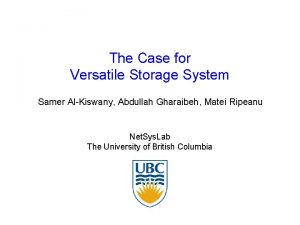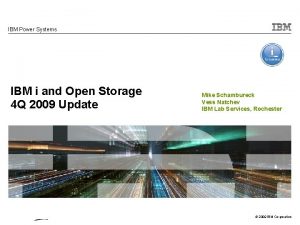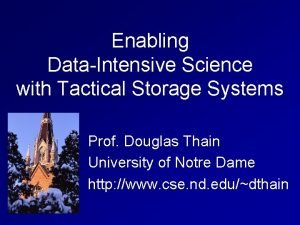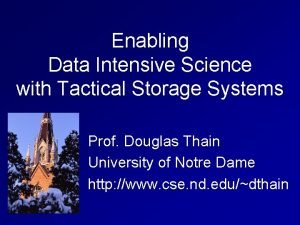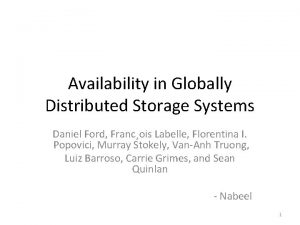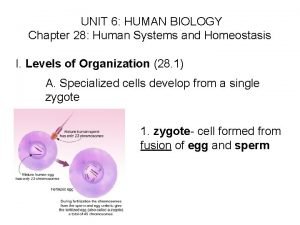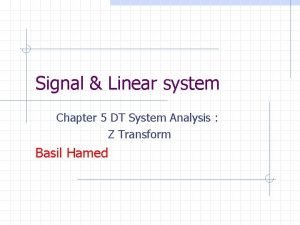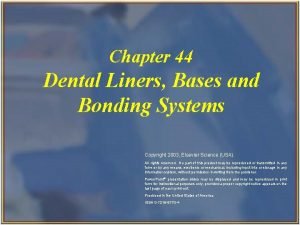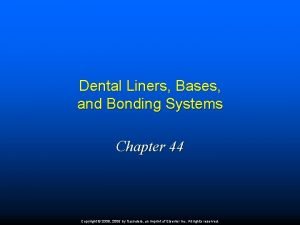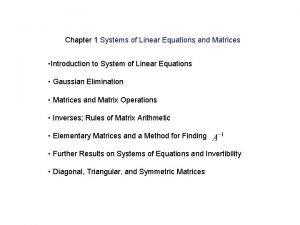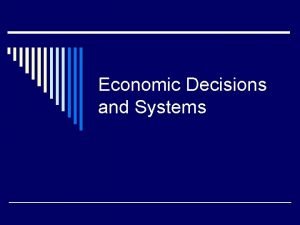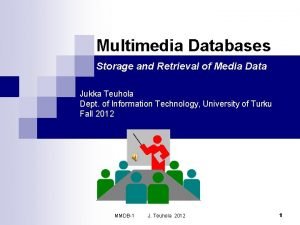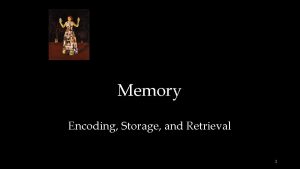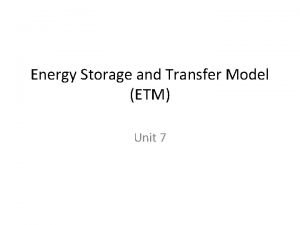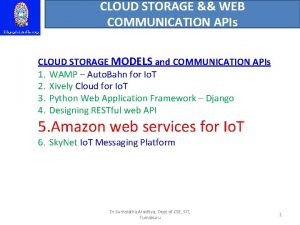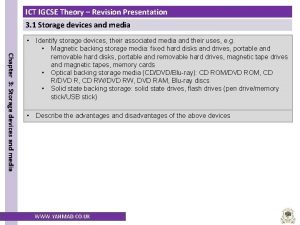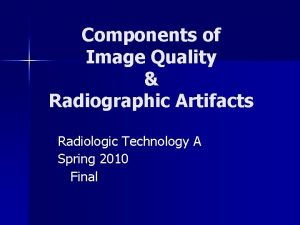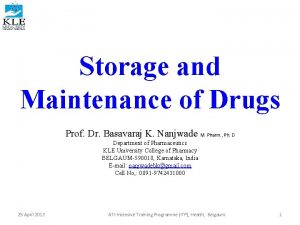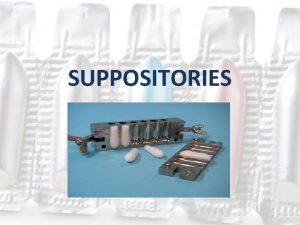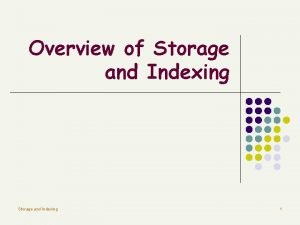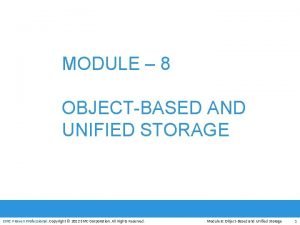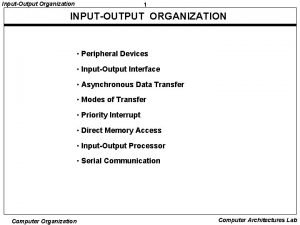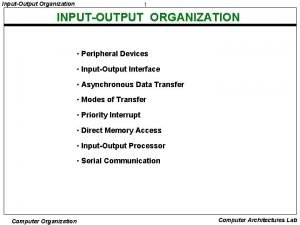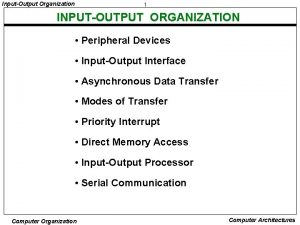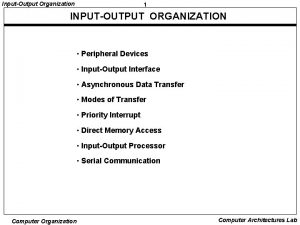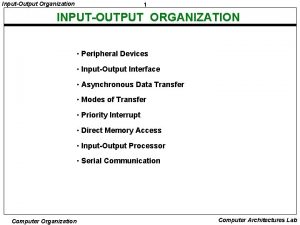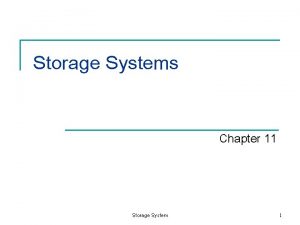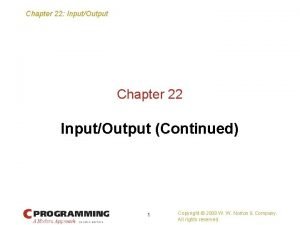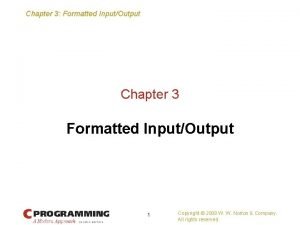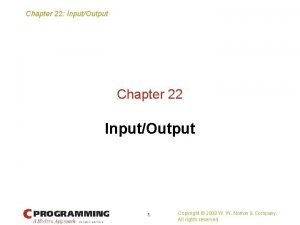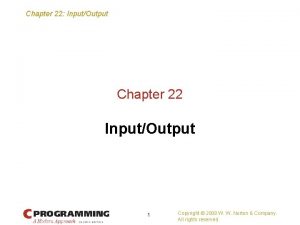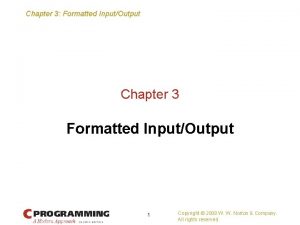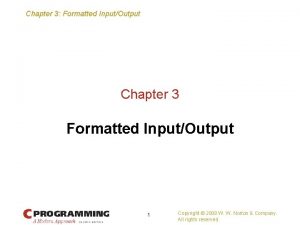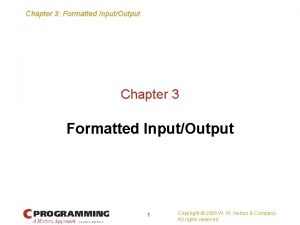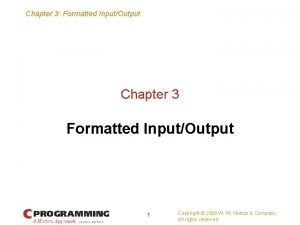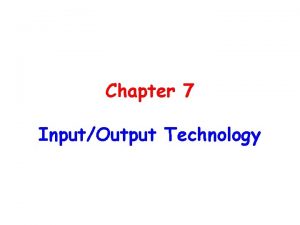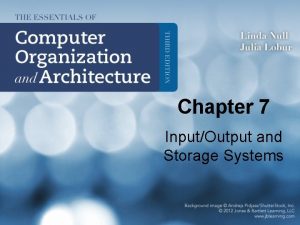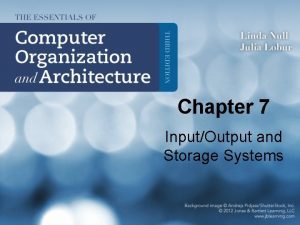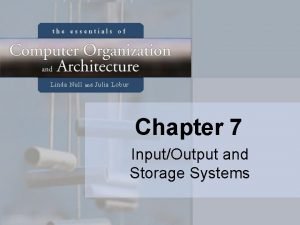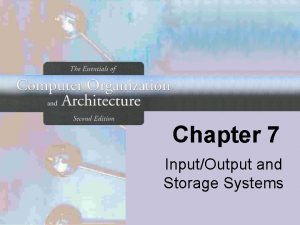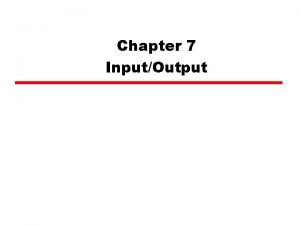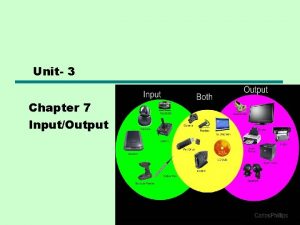Chapter 7 InputOutput and Storage Systems Chapter 7









































































- Slides: 73

Chapter 7 Input/Output and Storage Systems

Chapter 7 Objectives • Understand how I/O systems work, including I/O methods and architectures. • Become familiar with storage media, and the differences in their respective formats. • Understand how RAID improves disk performance and reliability, and which RAID systems are most useful today. • Be familiar with emerging data storage technologies and the barriers that remain to be overcome. 2

7. 1 Introduction • Data storage and retrieval is one of the primary functions of computer systems. – One could easily make the argument that computers are more useful to us as data storage and retrieval devices than they are as computational machines. • All computers have I/O devices connected to them, and to achieve good performance I/O should be kept to a minimum! • In studying I/O, we seek to understand the different types of I/O devices as well as how they work. 3

7. 2 I/O and Performance • Sluggish I/O throughput can have a ripple effect, dragging down overall system performance. – This is especially true when virtual memory is involved. • The fastest processor in the world is of little use if it spends most of its time waiting for data. • If we really understand what’s happening in a computer system we can make the best possible use of its resources. 4

7. 3 Amdahl’s Law • The overall performance of a system is a result of the interaction of all of its components. • System performance is most effectively improved when the performance of the most heavily used components is improved. • This idea is quantified by Amdahl’s Law: where S is the overall speedup; f is the fraction of work performed by a faster component; and k is the speedup of the faster component. 5

7. 3 Amdahl’s Law • Amdahl’s Law gives us a handy way to estimate the performance improvement we can expect when we upgrade a system component. • On a large system, suppose we can upgrade a CPU to make it 50% faster for $10, 000 or upgrade its disk drives for $7, 000 to make them 150% faster. • Processes spend 70% of their time running in the CPU and 30% of their time waiting for disk service. • An upgrade of which component would offer the greater benefit for the lesser cost? 6

7. 3 Amdahl’s Law • The processor option offers a 30% speedup: • And the disk drive option gives a 22% speedup: • Each 1% of improvement for the processor costs $333, and for the disk a 1% improvement costs $318. Should price/performance be your only concern? 7

7. 4 I/O Architectures • We define input/output as a subsystem of components that moves coded data between external devices and a host system. • I/O subsystems include: – – Blocks of main memory that are devoted to I/O functions. Buses that move data into and out of the system. Control modules in the host and in peripheral devices Interfaces to external components such as keyboards and disks. – Cabling or communications links between the host system and its peripherals. 8

7. 4 I/O Architectures This is a model I/O configuration. 9

7. 4 I/O Architectures • I/O can be controlled in five general ways. – Programmed I/O reserves a register for each I/O device. Each register is continually polled to detect data arrival. – Interrupt-Driven I/O allows the CPU to do other things until I/O is requested. – Memory-Mapped I/O shares memory address space between I/O devices and program memory. – Direct Memory Access (DMA) offloads I/O processing to a special-purpose chip that takes care of the details. – Channel I/O uses dedicated I/O processors. 10

7. 4 I/O Architectures This is an idealized I/O subsystem that uses interrupts. Each device connects interrupt line to the interrupt controller. The controller signals the CPU when any of the interrupt lines are asserted. 11

7. 4 I/O Architectures • Recall from Chapter 4 that in a system that uses interrupts, the status of the interrupt signal is checked at the top of the fetch-decode-execute cycle. • The particular code that is executed whenever an interrupt occurs is determined by a set of addresses called interrupt vectors that are stored in low memory. • The system state is saved before the interrupt service routine is executed and is restored afterward. We provide a flowchart on the next slide. 12

7. 4 I/O Architectures 13

7. 4 I/O Architectures • In memory-mapped I/O devices and main memory share the same address space. – Each I/O device has its own reserved block of memory. – Memory-mapped I/O therefore looks just like a memory access from the point of view of the CPU. – Thus the same instructions to move data to and from both I/O and memory, greatly simplifying system design. • In small systems the low-level details of the data transfers are offloaded to the I/O controllers built into the I/O devices. 14

7. 4 I/O Architectures This is a DMA configuration. Notice that the DMA and the CPU share the bus. The DMA runs at a higher priority and steals memory cycles from the CPU. 15

7. 4 I/O Architectures • Very large systems employ channel I/O. • Channel I/O consists of one or more I/O processors (IOPs) that control various channel paths. • Slower devices such as terminals and printers are combined (multiplexed) into a single faster channel. • On IBM mainframes, multiplexed channels are called multiplexor channels, the faster ones are called selector channels. 16

7. 4 I/O Architectures • Channel I/O is distinguished from DMA by the intelligence of the IOPs. • The IOP negotiates protocols, issues device commands, translates storage coding to memory coding, and can transfer entire files or groups of files independent of the host CPU. • The host has only to create the program instructions for the I/O operation and tell the IOP where to find them. 17

7. 4 I/O Architectures • This is a channel I/O configuration. 18

7. 4 I/O Architectures • Character I/O devices process one byte (or character) at a time. – Examples include modems, keyboards, and mice. – Keyboards are usually connected through an interruptdriven I/O system. • Block I/O devices handle bytes in groups. – Most mass storage devices (disk and tape) are block I/O devices. – Block I/O systems are most efficiently connected through DMA or channel I/O. 19

7. 4 I/O Architectures • I/O buses, unlike memory buses, operate asynchronously. Requests for bus access must be arbitrated among the devices involved. • Bus control lines activate the devices when they are needed, raise signals when errors have occurred, and reset devices when necessary. • The number of data lines is the width of the bus. • A bus clock coordinates activities and provides bit cell boundaries. 20

7. 4 I/O Architectures This is a generic DMA configuration showing how the DMA circuit connects to a data bus. 21

7. 4 I/O Architectures This is how a bus connects to a disk drive. 22

Timing diagrams, such as this one, define bus operation in detail. 23

7. 5 Data Transmission Modes • Bytes can be conveyed from one point to another by sending their encoding signals simultaneously using parallel data transmission or by sending them one bit at a time in serial data transmission. – Parallel data transmission for a printer resembles the signal protocol of a memory bus: 24

7. 5 Data Transmission Modes • In parallel data transmission, the interface requires one conductor for each bit. • Parallel cables are fatter than serial cables. • Compared with parallel data interfaces, serial communications interfaces: – Require fewer conductors. – Are less susceptible to attenuation. – Can transmit data farther and faster. Serial communications interfaces are suitable for timesensitive (isochronous) data such as voice and video. 25

7. 6 Magnetic Disk Technology • Magnetic disks offer large amounts of durable storage that can be accessed quickly. • Disk drives are called random (or direct) access storage devices, because blocks of data can be accessed according to their location on the disk. – This term was coined when all other durable storage (e. g. , tape) was sequential. • Magnetic disk organization is shown on the following slide. 26

7. 6 Magnetic Disk Technology Disk tracks are numbered from the outside edge, starting with zero. 27

7. 6 Magnetic Disk Technology • Hard disk platters are mounted on spindles. • Read/write heads are mounted on a comb that swings radially to read the disk. 28

7. 6 Magnetic Disk Technology • The rotating disk forms a logical cylinder beneath the read/write heads. • Data blocks are addressed by their cylinder, surface, and sector. 29

7. 6 Magnetic Disk Technology • There a number of electromechanical properties of hard disk drives that determine how fast its data can be accessed. • Seek time is the time that it takes for a disk arm to move into position over the desired cylinder. • Rotational delay is the time that it takes for the desired sector to move into position beneath the read/write head. • Seek time + rotational delay = access time. 30

7. 6 Magnetic Disk Technology • Transfer rate gives us the rate at which data can be read from the disk. • Average latency is a function of the rotational speed: • Mean Time To Failure (MTTF) is a statisticallydetermined value often calculated experimentally. – It usually doesn’t tell us much about the actual expected life of the disk. Design life is usually more realistic. Figure 7. 15 in the text shows a sample disk specification. 31

7. 6 Magnetic Disk Technology • Low cost is the major advantage of hard disks. • But their limitations include: – Very slow compared to main memory – Fragility – Moving parts wear out • Reductions in memory cost enable the widespread adoption of solid state drives, SSDs. – Computers "see" SSDs as jut another disk drive, but they store data in non-volatile flash memory circuits. – Flash memory is also found in memory sticks and MP 3 players. 32

7. 6 Magnetic Disk Technology • SSD access time and transfer rates are typically 100 times faster than magnetic disk, but slower than onboard RAM by a factor of 100, 000. – There numbers vary widely among manufacturers and interface methods. • Unlike RAM, flash is block-addressable (like disk drives). – The duty cycle of flash is between 30, 000 and 1, 000 updates to a block. – Updates are spread over the entire medium through wear leveling to prolong the life of the SSD. 33

7. 6 Magnetic Disk Technology • SSD specifications share many common metrics with HDDs. – Clearly, there is no need for any metrics that concern spinning platters, such as rotational delay. – Compare Figs 7. 15 with 7. 17 in your text. • Enterprise SSDs must maintain the highest degree of performance and reliability. – Onboard cache memories are backed up by capacitors that briefly hold a charge during a power failure, giving time to commit pending writes. 34

7. 6 Magnetic Disk Technology • The Joint Electron Devices Engineering Council (JEDEC) sets standards for SSD performance and reliability metrics. The most important are: • Unrecoverable Bit Error Ratio (UBER) and terabytes written (TBW). TBW is a measure of disk endurance (or service life) and UBER is a measure of disk reliability. – UBER is calculated by dividing the number of data errors by the number of bits read using a simulated lifetime workload. – TBW is the number of terabytes that can be written to the disk before the disk fails to meet specifications for speed and error rates. 35

7. 7 Optical Disks • Optical disks provide large storage capacities very inexpensively. • They come in a number of varieties including CDROM, DVD, and WORM. • Many large computer installations produce document output on optical disk rather than on paper. This idea is called COLD-- Computer Output Laser Disk. • It is estimated that optical disks can endure for a hundred years. Other media are good for only a decade-- at best. 36

7. 7 Optical Disks • CD-ROMs were designed by the music industry in the 1980 s, and later adapted to data. • This history is reflected by the fact that data is recorded in a single spiral track, starting from the center of the disk and spanning outward. • Binary ones and zeros are delineated by bumps in the polycarbonate disk substrate. The transitions between pits and lands define binary ones. • If you could unravel a full CD-ROM track, it would be nearly five miles long! 37

7. 7 Optical Disks • The logical data format for a CD-ROM is much more complex than that of a magnetic disk. (See the text for details. ) • Different formats are provided for data and music. • Two levels of error correction are provided for the data format. • Because of this, a CD holds at most 650 MB of data, but can contain as much as 742 MB of music. 38

7. 7 Optical Disks • DVDs can be thought of as quad-density CDs. – Varieties include single sided, single layer, single sided double layer, double sided double layer, and double sided double layer. • Where a CD-ROM can hold at most 650 MB of data, DVDs can hold as much as 17 GB. • One of the reasons for this is that DVD employs a laser that has a shorter wavelength than the CD’s laser. • This allows pits and lands to be closer together and the spiral track to be wound tighter. 39

7. 7 Optical Disks • A shorter wavelength light can read and write bytes in greater densities than can be done by a longer wavelength laser. • This is one reason that DVD’s density is greater than that of CD. • The 405 nm wavelength of blue-violet light is much shorter than either red (750 nm) or orange (650 nm). • The manufacture of blue-violet lasers can now be done economically, bringing about the next generation of laser disks. 40

7. 7 Optical Disks • The Blu-Ray disc format won market dominance over HD-CD owing mainly to the influence of Sony. – HD-CDs are backward compatible with DVD, but hold less data. • Blu-Ray was developed by a consortium of nine companies that includes Sony, Samsung, and Pioneer. – Maximum capacity of a single layer Blu-Ray disk is 25 GB. – Multiple layers can be "stacked" up to six deep. – Only double-layer disks are available for home use. 41

7. 7 Optical Disks • Blue-violet laser disks are also used in the data center. • The intention is to provide a means for long term data storage and retrieval. • Two types are now dominant: – Sony’s Professional Disk for Data (PDD) that can store 23 GB on one disk and – Plasmon’s Ultra Density Optical (UDO) that can hold up to 30 GB. • It is too soon to tell which of these technologies will emerge as the winner. 42

7. 8 Magnetic Tape • First-generation magnetic tape was not much more than wide analog recording tape, having capacities under 11 MB. • Data was usually written in nine vertical tracks: 43

7. 8 Magnetic Tape • Today’s tapes are digital, and provide multiple gigabytes of data storage. • Two dominant recording methods are serpentine and helical scan, which are distinguished by how the read-write head passes over the recording medium. • Serpentine recording is used in digital linear tape (DLT) and Quarter inch cartridge (QIC) tape systems. • Digital audio tape (DAT) systems employ helical scan recording. These two recording methods are shown on the next slide. 44

7. 8 Magnetic Tape Serpentine 45

7. 8 Magnetic Tape Helical Scan 46

7. 8 Magnetic Tape • Numerous incompatible tape formats emerged over the years. – Sometimes even different models of the same manufacturer’s tape drives were incompatible! • Finally, in 1997, HP, IBM, and Seagate collaboratively invented a best-of-breed tape standard. • They called this new tape format Linear Tape Open (LTO) because the specification is openly available. 47

7. 8 Magnetic Tape • LTO, as the name implies, is a linear digital tape format. • The specification allowed for the refinement of the technology through four “generations. ” • Generation 5 was released in 2010. – Without compression, the tapes support a transfer rate of 208 MB per second and each tape can hold up to 1. 4 TB. • LTO supports several levels of error correction, providing superb reliability. – Tape has a reputation for being an error-prone medium. 48

7. 9 RAID • RAID, an acronym for Redundant Array of Independent Disks was invented to address problems of disk reliability, cost, and performance. • In RAID, data is stored across many disks, with extra disks added to the array to provide error correction (redundancy). • The inventors of RAID, David Patterson, Garth Gibson, and Randy Katz, provided a RAID taxonomy that has persisted for a quarter of a century, despite many efforts to redefine it. 49

7. 9 RAID • RAID Level 0, also known as drive spanning, provides improved performance, but no redundancy. – Data is written in blocks across the entire array – The disadvantage of RAID 0 is in its low reliability. 50

7. 9 RAID • RAID Level 1, also known as disk mirroring, provides 100% redundancy, and good performance. – Two matched sets of disks contain the same data. – The disadvantage of RAID 1 is cost. 51

7. 9 RAID • A RAID Level 2 configuration consists of a set of data drives, and a set of Hamming code drives. – Hamming code drives provide error correction for the data drives. – RAID 2 performance is poor and the cost is relatively high. 52

7. 9 RAID • RAID Level 3 stripes bits across a set of data drives and provides a separate disk for parity. – Parity is the XOR of the data bits. – RAID 3 is not suitable for commercial applications, but is good for personal systems. 53

7. 9 RAID • RAID Level 4 is like adding parity disks to RAID 0. – Data is written in blocks across the data disks, and a parity block is written to the redundant drive. – RAID 4 would be feasible if all record blocks were the same size. 54

7. 9 RAID • RAID Level 5 is RAID 4 with distributed parity. – With distributed parity, some accesses can be serviced concurrently, giving good performance and high reliability. – RAID 5 is used in many commercial systems. 55

7. 9 RAID • RAID Level 6 carries two levels of error protection over striped data: Reed-Soloman and parity. – It can tolerate the loss of two disks. – RAID 6 is write-intensive, but highly fault-tolerant. 56

7. 9 RAID • Double parity RAID (RAID DP) employs pairs of overlapping parity blocks that provide linearly independent parity functions. 57

7. 9 RAID • Like RAID 6, RAID DP can tolerate the loss of two disks. • The use of simple parity functions provides RAID DP with better performance than RAID 6. • Of course, because two parity functions are involved, RAID DP’s performance is somewhat degraded from that of RAID 5. – RAID DP is also known as EVENODD, diagonal parity RAID, RAID 5 DP, advanced data guarding RAID (RAID ADG) and-- erroneously-- RAID 6. 58

7. 9 RAID • Large systems consisting of many drive arrays may employ various RAID levels, depending on the criticality of the data on the drives. – A disk array that provides program workspace (say for file sorting) does not require high fault tolerance. • Critical, high-throughput files can benefit from combining RAID 0 with RAID 1, called RAID 10. • RAID 50 combines striping and distributed parity. For good fault tolerance and high capacity. – Note: Higher RAID levels do not necessarily mean “better” RAID levels. It all depends upon the needs of the applications that use the disks. 59

7. 10 The Future of Data Storage • Advances in technology have defied all efforts to define the ultimate upper limit for magnetic disk storage. – In the 1970 s, the upper limit was thought to be around 2 Mb/in 2. – Today’s disks commonly support 20 Gb/in 2. • Improvements have occurred in several different technologies including: – Materials science – Magneto-optical recording heads. – Error correcting codes. 60

7. 10 The Future of Data Storage • As data densities increase, bit cells consist of proportionately fewer magnetic grains. • There is a point at which there are too few grains to hold a value, and a 1 might spontaneously change to a 0, or vice versa. • This point is called the superparamagnetic limit. – In 2006, the superparamagnetic limit is thought to lie between 150 Gb/in 2 and 200 Gb/in 2. • Even if this limit is wrong by a few orders of magnitude, the greatest gains in magnetic storage have probably already been realized. 61

7. 10 The Future of Data Storage • Future exponential gains in data storage most likely will occur through the use of totally new technologies. • Research into finding suitable replacements for magnetic disks is taking place on several fronts. • Some of the more interesting technologies include: – Biological materials Carbon nanotubes – Holographic systems Memristors – Micro-electro-mechanical devices 62

7. 10 The Future of Data Storage • Present day biological data storage systems combine organic compounds such as proteins or oils with inorganic (magentizable) substances. • Early prototypes have encouraged the expectation that densities of 1 Tb/in 2 are attainable. • Of course, the ultimate biological data storage medium is DNA. – Trillions of messages can be stored in a tiny strand of DNA. • Practical DNA-based data storage is most likely decades away. 63

7. 10 The Future of Data Storage • Holographic storage uses a pair of laser beams to etch a three-dimensional hologram onto a polymer medium. 64

7. 10 The Future of Data Storage • Data is retrieved by passing the reference beam through the hologram, thereby reproducing the original coded object beam. 65

7. 10 The Future of Data Storage • Because holograms are three-dimensional, tremendous data densities are possible. • Experimental systems have achieved over 30 Gb/in 2, with transfer rates of around 1 GBps. • In addition, holographic storage is content addressable. – This means that there is no need for a file directory on the disk. Accordingly, access time is reduced. • The major challenge is in finding an inexpensive, stable, rewriteable holographic medium. 66

7. 10 The Future of Data Storage • Micro-electro-mechanical storage (MEMS) devices offer another promising approach to mass storage. • IBM’s Millipede is one such device. • Prototypes have achieved densities of 100 Gb/in 2 with 1 Tb/in 2 expected as the technology is refined. A photomicrograph of Millipede is shown on the next slide. 67

7. 10 The Future of Data Storage • Millipede consists of thousands of cantilevers that record a binary 1 by pressing a heated tip into a polymer substrate. • The tip reads a binary 1 when it dips into the imprint in the polymer Photomicrograph courtesy of the IBM Corporation. © 2005 IBM Corporation 68

7. 10 The Future of Data Storage • CNTs are a cylindrical form of elemental carbon: The walls of the cylinders are one atom thick. • CNTs can act like switches, opening and closing to store bits. • Once “set” the CNT stays in place until a release voltage is applied. 69

7. 10 The Future of Data Storage • Memristors are electronic components that combine the properties of a resistor with memory. • Resistance to current flow can be controlled so that states of “high” and “low” store data bits. • Like CNTs, memristor memories are non-volatile, holding their state until certain threshold voltages are applied. • These non-volatile memories promise enormous energy savings and increased data access speeds in the very near future. 70

Chapter 7 Conclusion • I/O systems are critical to the overall performance of a computer system. • Amdahl’s Law quantifies this assertion. • I/O systems consist of memory blocks, cabling, control circuitry, interfaces, and media. • I/O control methods include programmed I/O, interrupt-based I/O, DMA, and channel I/O. • Buses require control lines, a clock, and data lines. Timing diagrams specify operational details. 71

Chapter 7 Conclusion • Magnetic disk is the principal form of durable storage. • Disk performance metrics include seek time, rotational delay, and reliability estimates. • Enterprise SSDs save energy and provide improved data access for government and industry. • Optical disks provide long-term storage for large amounts of data, although access is slow. • Magnetic tape is also an archival medium sill widely used. 72

Chapter 7 Conclusion • RAID gives disk systems improved performance and reliability. RAID 3 and RAID 5 are the most common. • RAID 6 and RAID DP protect against dual disk failure, but RAID DP offers better performance. • Any one of several new technologies including biological, holographic, CNT, memristor, or mechanical may someday replace magnetic disks. • The hardest part of data storage may be in locating the data after it’s stored. 73
 Inputoutput devices
Inputoutput devices Secondary storage vs primary storage
Secondary storage vs primary storage Storage devices of computer
Storage devices of computer Uses rigid metallic platters
Uses rigid metallic platters Unified storage vs traditional storage
Unified storage vs traditional storage Versatile storage systems
Versatile storage systems Storage for ibm power systems
Storage for ibm power systems Tactical storage systems
Tactical storage systems Tactical storage systems
Tactical storage systems Availability in globally distributed storage systems
Availability in globally distributed storage systems Decision support systems and intelligent systems
Decision support systems and intelligent systems Selection and storage of meats chapter 13
Selection and storage of meats chapter 13 Chapter 19 food safety and storage
Chapter 19 food safety and storage Dicapine
Dicapine Embedded systems vs cyber physical systems
Embedded systems vs cyber physical systems Engineering elegant systems: theory of systems engineering
Engineering elegant systems: theory of systems engineering Chapter 24 the immune and lymphatic systems and cancer
Chapter 24 the immune and lymphatic systems and cancer What empties into the left subclavian vein
What empties into the left subclavian vein Chapter 28 human systems and homeostasis
Chapter 28 human systems and homeostasis Signals and systems oppenheim solutions chapter 5
Signals and systems oppenheim solutions chapter 5 Chapter 13 federal and state court systems
Chapter 13 federal and state court systems Chapter 2 economic systems and decision making answer key
Chapter 2 economic systems and decision making answer key Section 38-3 the excretory system
Section 38-3 the excretory system Chapter 39 endocrine and reproductive systems
Chapter 39 endocrine and reproductive systems Chapter 36 skeletal muscular and integumentary systems
Chapter 36 skeletal muscular and integumentary systems Chapter 33 section 1 the circulatory system
Chapter 33 section 1 the circulatory system Chapter 2 economic systems and decision making
Chapter 2 economic systems and decision making Water and aqueous systems chapter 15 answers
Water and aqueous systems chapter 15 answers Water and aqueous systems chapter 15 answers
Water and aqueous systems chapter 15 answers Chapter 14 the skeletal muscular and nervous systems
Chapter 14 the skeletal muscular and nervous systems What is the musical classification of shank
What is the musical classification of shank Chapter 15 water and aqueous systems answer key
Chapter 15 water and aqueous systems answer key Chapter 7 systems of equations and inequalities answers
Chapter 7 systems of equations and inequalities answers Dental liners bases and bonding systems
Dental liners bases and bonding systems Chapter 2 economic systems and decision making
Chapter 2 economic systems and decision making An example of enamel bonding is the placement of a
An example of enamel bonding is the placement of a Chapter 7 systems of equations and inequalities answers
Chapter 7 systems of equations and inequalities answers Chapter 4 ethical issues
Chapter 4 ethical issues Homogeneous system of linear equations matrix
Homogeneous system of linear equations matrix Chapter 1 economic decisions and systems answer key
Chapter 1 economic decisions and systems answer key Chapter 6 systems of equations and inequalities
Chapter 6 systems of equations and inequalities 4 components of an information system
4 components of an information system Chapter 3 information systems organizations and strategy
Chapter 3 information systems organizations and strategy Chapter 2: economic systems worksheet answer key
Chapter 2: economic systems worksheet answer key Chapter 15 water and aqueous systems
Chapter 15 water and aqueous systems Chapter 15 water and aqueous systems
Chapter 15 water and aqueous systems Storage of starch and sauces
Storage of starch and sauces San y nas
San y nas Storage and retrieval technologies in multimedia
Storage and retrieval technologies in multimedia Memory encoding techniques
Memory encoding techniques Long term storage and retrieval
Long term storage and retrieval Material handling and storage safety ppt
Material handling and storage safety ppt Advantages and disadvantages of hard engineering
Advantages and disadvantages of hard engineering Energy storage and transfer model test
Energy storage and transfer model test Database and storage architectures
Database and storage architectures Memory encoding
Memory encoding Cloud storage models & communication apis
Cloud storage models & communication apis Selecting and storing eggs
Selecting and storing eggs A limited access zone must
A limited access zone must Storage binding and lifetime
Storage binding and lifetime Ict igcse theory
Ict igcse theory Guide shoe mark artifact
Guide shoe mark artifact The flow of food purchasing receiving and storage
The flow of food purchasing receiving and storage Introduction to san and nas storage
Introduction to san and nas storage Register storage
Register storage Emc information storage and management
Emc information storage and management Floating storage and regasification unit market
Floating storage and regasification unit market The flow of food purchasing receiving and storage
The flow of food purchasing receiving and storage Storage and maintenance of drugs
Storage and maintenance of drugs Vaccine storage and handling sop worksheet
Vaccine storage and handling sop worksheet Vaccine storage and handling protocol
Vaccine storage and handling protocol Miscellaneous suppository base
Miscellaneous suppository base Overview of storage and indexing
Overview of storage and indexing Object based and unified storage
Object based and unified storage





